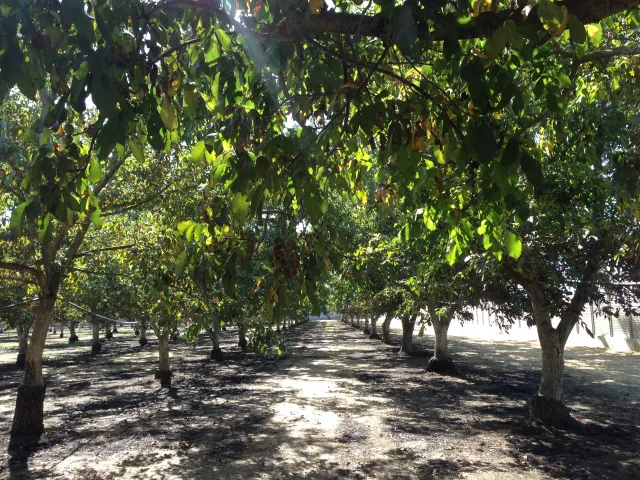By Ellen Bruno and Nick Hagerty
California is now ten years into a revolution in groundwater management. In 2014, the state passed the Sustainable Groundwater Management Act (SGMA) which requires newly formed local groundwater sustainability agencies to develop long-term plans to reduce overdraft by 2040. To date, more than 250 local agencies have written and begun implementing groundwater sustainability plans, with more than 100 plans in action. This has taken enormous effort and represents a significant departure from the prior status quo for groundwater management in California.
Many wonder, however, if SGMA is affecting behavior around the use of the groundwater resource yet. Are farmers making decisions around planting or drilling new groundwater wells with future SGMA reductions in mind? If so, are they switching away from permanent crops that may not have available water through 2040? We set out to answer those questions with publicly available data.
Detecting Behavior Change
Measuring the early effects of SGMA on farmer decisions is challenging. One obvious way might be to look at statewide trends in planting or drilling since 2014. But the answers might be misleading. For example, perennial crops have massively increased since 2014. But is that because of SGMA, or because almonds are so profitable that growers are planting them despite SGMA? To find out, we need to make a more careful comparison.
We decided to compare rates of well construction and perennial plantings on either side of groundwater agency boundaries with different levels of overdraft. Presumably, basins with greater overdraft will have more stringent water use reduction requirements under SGMA, and those facing more stringent requirements may act differently. We focused specifically on planting and well drilling decisions of farmers, since those are the main margins through which a grower can adjust their water use. Both well drilling and the decision to plant a perennial crop like almonds or pistachios are capital-intensive investments that depend on the future availability of groundwater.
If we compare outcomes on farmland that is close to the boundary between agencies, then we can assume that those growers face similar farming conditions, and the only difference between them is future local SGMA requirements. Groundwater can still move underground across agency boundaries, so farmers on either side face similar groundwater conditions today but different future water supplies under SGMA. For example, a grower on one side may face future cutbacks of 1 acre-foot/acre to comply with SGMA requirements, while a grower on the other side may face cutbacks of .25 acre-foot /acre, even though both farm in similar soils, climate, and economic conditions, and experience similar costs to pump groundwater.
We focused specifically on outcomes in 2020 and 2021 – two years when expectations about future groundwater regulation under SGMA were first becoming clear to farmers. Importantly, we examined differences in outcomes between farmers on either side of a boundary and compared these differences to those in 2014 before SGMA passed. We further controlled for surface water deliveries which may vary among farmers in different subbasins and impact their planting and drilling decisions. In total, we examined data across all 73 pairs of neighboring subbasins within the Central Valley. Our results are the average effects across all these parcel-level comparisons.

Walnut fields in the Sacramento Valley. Photo by Ellen Bruno.
Are Farmers Adjusting?
Through the analysis, we found no detectable differences in the planting and well-drilling decisions that farmers are making between bordering parcels in agencies facing greater or lesser water use reduction requirements under SGMA. The differences in planting rates in 2020 and 2021 between neighboring agencies were the same as their differences in 2014 before SGMA was announced. We concluded that there’s no evidence of SGMA slowing the rate of well construction or perennial plantings in these early years of implementation.
Why could this be? One explanation is that our data is imperfect and as a result we estimate effects with noise. As with any statistical analysis that finds null effects, it’s hard to know if that’s because the effect is zero or because the magnitude is small relative to the noise in the data. But we don’t think this is the case because even the range of estimates that we can predict with high confidence is quite small.
Another explanation is that farmers are betting (correctly or not) that SGMA regulations will not be strongly enforced. But we also think this is unlikely because rural appraiser reports and recent studies confirm that landowners are taking this regulation into consideration, with evidence of impacts to land prices.
This leaves one final explanation: SGMA regulations are too far in the future, and producers are focused on today’s operational needs and near-term profitability. In other words, farmers are making a choice to delay these changes.
What are the implications of the findings? Adjustments are needed to achieve sustainable groundwater management goals by 2040. The lack of apparent response in the early years of SGMA implementation suggests that if farmers adjust, it will likely come closer to 2040. Delaying adjustments means that for now, farmers will continue to drill wells and pump groundwater, exacerbating the groundwater overdraft problems that SGMA seeks to address.
This long transition period, while helpful for everyone adjusting to the law, also means that the groundwater overdraft problem will get worse before it gets better.
Ellen Bruno is an Associate CE Specialist at UC Berkeley in the Department of Agricultural and Resource Economics. Nick Hagerty is an Assistant Professor in the Department of Agricultural Economics and Economics at Montana State University.
For more, check out our ARE Update article: https://s.giannini.ucop.edu/uploads/pub/2025/04/30/v28n4_2.pdf.
To see the full analysis, see https://doi.org/10.1016/j.jeem.2025.103183.

